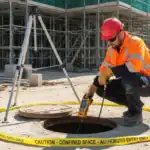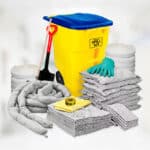
All employers in the UK have a legal duty to provide a safe place of work for their employees and for members of the public. They must enact measures to protect the health and safety of all persons in the workplace and ensure that adequate welfare facilities are provided.
These obligations are enforced by the Health and Safety at Work etc Act 1974. The Workplace Health Safety and Welfare Regulations 1992 provides more detail on these duties and outlines the minimum safety requirements for UK workplaces.
Every employer should have a good understanding of the safety precautions and specifications contained in the Workplace Health Safety and Welfare Regulations 1992. Failure to implement these regulations can result in significant penalties, such as fines or even legal action.
Background of the Workplace Health and Safety and Welfare Regulations
The Workplace Health Safety and Welfare Regulations 1992 were brought into UK law as of the 1st of January 1993. The regulations implemented the minimum safety requirements for workplaces as outlined under the European Commission Workplace Directive (89/654/EEC).
Following the Workplace Health Safety and Welfare Regulations 1992, UK employers were required to implement a broad range of health and safety standards. Although there are some exceptions, such as construction sites, the Workplace Health Safety and Welfare Regulations 1992 are applicable to most work environments.
These regulations marked a significant step towards creating safer and more conducive workplaces, ensuring the well-being of employees and promoting a culture of occupational safety.
Health and Safety Courses
Our health and safety courses support legal compliance and effective risk management. They raise awareness of common workplace hazards and teach the fundamentals of safe working.
Important Definitions
Under the Workplace (Health Safety and Welfare) Regulations 1992, the following definitions apply:
- Workplace – All places where the Workplace Health Safety and Welfare Regulations 1992 are applicable. This includes shops, offices, factories, schools, hospitals, hotels and entertainment venues
- Work – Pertains to duties performed by an employed or self-employed person
- Premises – Any place of work, including outdoor areas
- Domestic premises – A private dwelling. The Workplace Health Safety and Welfare Regulations 1992 do not apply to domestic premises
- Disabled person – As defined by section one of the Disability Discrimination Act 1995 as a person that has a ‘physical or mental impairment which has a substantial and long-term adverse effect on a person’s ability to carry out normal day-to-day activities’
Requirements of the Workplace Health Safety and Welfare Regulations 1992
The Workplace Health Safety and Welfare Regulations 1992 stipulates requirements that cover three main areas:
- Health
- Safety
- Welfare
Each of these areas contains specific measures relating to health and safety concerns in the workplace.
Health
Ventilation
Workplaces must have adequate ventilation and an outside source of fresh, clean air. Ventilation systems should provide adequate movement of air and remove and dilute humid air. The workplace must have breathable air and a comfortable atmosphere with no unpleasant draughts.
In many workplaces, this can be achieved via open windows. However, workplaces with large amounts of vapour, dust or fumes may require mechanical ventilation systems.
Indoor Workplace Temperatures
All indoor workplaces must maintain a comfortable temperature. An office environment should have a minimum temperature of 16 °C and an environment where physical work is performed should have a minimum temperature of 13 °C (unless otherwise mandated by law).
Work Performed in Hot or Cold Environments
Risk assessments need to be undertaken wherever workers must perform their duties in extreme temperatures of hot or cold. Measures should be instigated to eliminate or mitigate risks posed by the thermal effects of hot or cold temperatures.
Lighting
Lighting levels should be sufficient for workers to complete their tasks safely. Glare or inadequate lighting is to be avoided. Where possible, natural light is to be provided. All lighting and light fittings should be safe to use. If sudden loss of light would pose a risk to health and safety, an automatic emergency lighting system should be installed.
Cleanliness and Waste Materials
All workplace areas, fittings, equipment and furniture should be kept clean and sanitary. This includes floors, walls and ceilings. All waste should be disposed of in suitable containers. Regular cleaning must be performed.
Room Dimensions and Space
There should be sufficient space for people to move around freely. The minimum amount of space is defined as 11 cubic metres per person when empty of furniture and equipment. This is to be based on the actual height of the room or an average of three metres.
Workstations and Seating
All workstations should be appropriate for the persons using them and the duties they must undertake. If an emergency situation arises, workers should be able to leave workstations easily and promptly. Seating should provide adequate ergonomic back support and footrests should be supplied.
Safety
All workstations should be appropriate for the persons using them and the duties they must undertake. If an emergency situation arises, workers should be able to leave workstations easily and promptly. Seating should provide adequate ergonomic back support and footrests should be supplied.
Maintenance
Equipment, devices and the workplace itself should be maintained so they are safe and in good working order. Some items may require formal maintenance to be carried out. The overall condition of buildings should be regularly monitored to ensure they are stable and solid.
Floors and Traffic Routes
Traffic routes should allow for ease of movement. Pedestrians, vehicles and equipment must be able to move safely. There should be adequate separation between pedestrians and vehicles. Any pedestrian doors or entrances should also have sufficient separation from traffic routes. Speed limits, one-way systems, route markings and signage should be used to enhance safety.
All flooring and traffic routes must be of suitable strength for the loads placed upon them. Any damage to the surface of floors or traffic routes should be repaired as soon as possible.
Falls into Dangerous Substances
Dangerous substances contained in pits, tanks or other types of structures must be fenced off. The obligations of employers in relation to falls are now covered by the Work at Height Regulations 2005.
Transparent or Translucent Doors, Gates or Walls and Windows
All transparent or translucent surfaces must be constructed from safety material or have adequate protection from breakage. Signage may be required if there is a risk of people coming into contact with any transparent or translucent surfaces.
Windows
All windows that can be opened or adjusted should be able to do so without the risk of harm. Windows and skylights should be able to be cleaned safely.
Doors and Gates
Doors and gates must be well-constructed and, if necessary, have safety devices fitted. If they swing both directions or open onto traffic routes, they should have a viewing panel installed. Any upward-opening doors or gates must have a device fitted to stop them from falling back into place. Mechanical vertical doors need to be fitted with safety measures to prevent injury.
Escalators and Moving Walkways
Escalators and moving walkways should operate safely and be fitted with safety devices. They must have one or more emergency stop controls that are obvious and easily accessible.
Welfare
Sanitary Conveniences and Washing Facilities
Sanitary conveniences and washing facilities must be well lit, accessible, ventilated and have hot and cold water, soap and towels. If required, showers must be provided. Men’s and women’s areas should be separate unless each convenience is in a separate room with a locking door.
Drinking Water
Clean drinking water must be supplied. Suitable cups or an upward drinking jet should also be provided. Water can also be provided in refillable enclosed containers, if it cannot be obtained from a mains outlet. Bottled water or water dispensing systems can be used as secondary water sources.
Accommodation for Clothing and Changing Facilities
Workers should have easily accessible, adequate space to change in private and be able to securely store their own clothes.
Facilities for Rest and to Eat Meals
Rest facilities and meal areas should be provided. These areas should be kept clean and have seating, tables and the means to prepare hot food and drink. Rest facilities should be provided for pregnant women.
Learn More About Legislation Relating to Health and Safety
The Workplace Health Safety and Welfare Regulations 1992 ensure the welfare, health and safety of all employees and other persons. Participating in training will make certain that your business and your employees comply with relevant legislation relating to health and safety. A range of accredited online health and safety training courses can be found on the Human Focus website.





















